Pas-de-Calais boasts six bell towers – or belfries – that have been raised over the centuries. Symbols of wealth in times past, they are part of our heritage and epitomise our history and the power of their respective towns.
Decorated with sculptures of personalities, gargoyles, lions… they overlook a château, a church, a cathedral or a town.
Built century after century, these belfries have served as watchtowers, arsenals, prisons… each one has a story to tell and their own particular spirit that you can feel.
The bell towers have been listed as World Heritage by UNESCO since 2005.
Set out to explore them!
The Unesco listed bell tower with a 16-bell carillon in Aire-sur-la-Lys
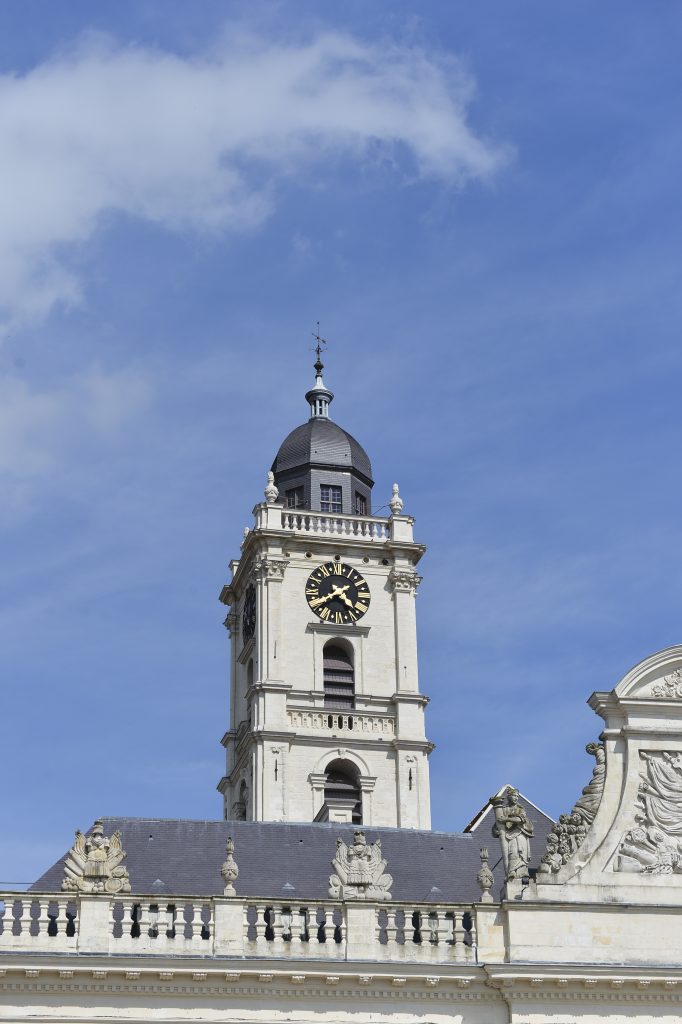
Situated at the rear of the town hall, the bell tower of Aire-sur-la-Lys is in the Baroque style and rests upon four large pillars of brick and stone that are each two metres wide.
The belfry has fulfilled a number of roles. It has served as a watchtower, standing sentinel over the city, from which a watchman would raise the alarm in case of fire or to warn the local inhabitants of the approach of an enemy’s army by sounding his horn.
It was also a prison and a strong room in which the town charters, seals and treasure were held in a safe.
The first bell tower was constructed in 1179, but two fires ravaged the belfry. It was rebuilt in 1447, but would suffer another catastrophe when, in 1708, it fell into disrepair and began to crumble. In 1715, Louis XIV ordered its reconstruction, which was completed in 1724.
In 1914 there was another fire. The clock, carillon and two large bells fell onto the vaulted ceiling of the Salle du Loup room located on the 1st floor. It was following this date that it stopped being used as a lookout and no longer kept watch over the city from its tall tower …
Every quarter of an hour the carillon of 16 bells plays popular tunes.
FIND OUT MORE HERE
Tourist information centre Tel 00333.21.39.65.66
Arras’s Gothic bell tower and its son et lumière show
Construction of the belfry in Arras began in 1463 and was completed 91 years later.
From its height of 75m, this tower in the Gothic style overlooks the town hall and the famous Place d’Arras.
The bell tower is topped with the Imperial crown of Charles Quint, inspired by the Beffroi d’Audenarde (Belgium), a reminder that the county of Artois once belonged to the Holy Roman Germanic Empire.
In 1914, the ensemble (the belfry and town hall) suffered from the bombardments and would be faithfully rebuilt between 1924 and 1932.
Listed as World Heritage by UNESCO, and one of France’s favourite national monuments, the bell tower of Arras offers superb views over the city and the surrounding countryside. Visitors can access the first level via a lift, but then need to scale around forty steps in order to reach the summit.
Every September, to close the Festival of Arras, a son et lumière 2.0 show, that is to say entirely lights and no fireworks, is projected onto it.
FIND OUT MORE HERE
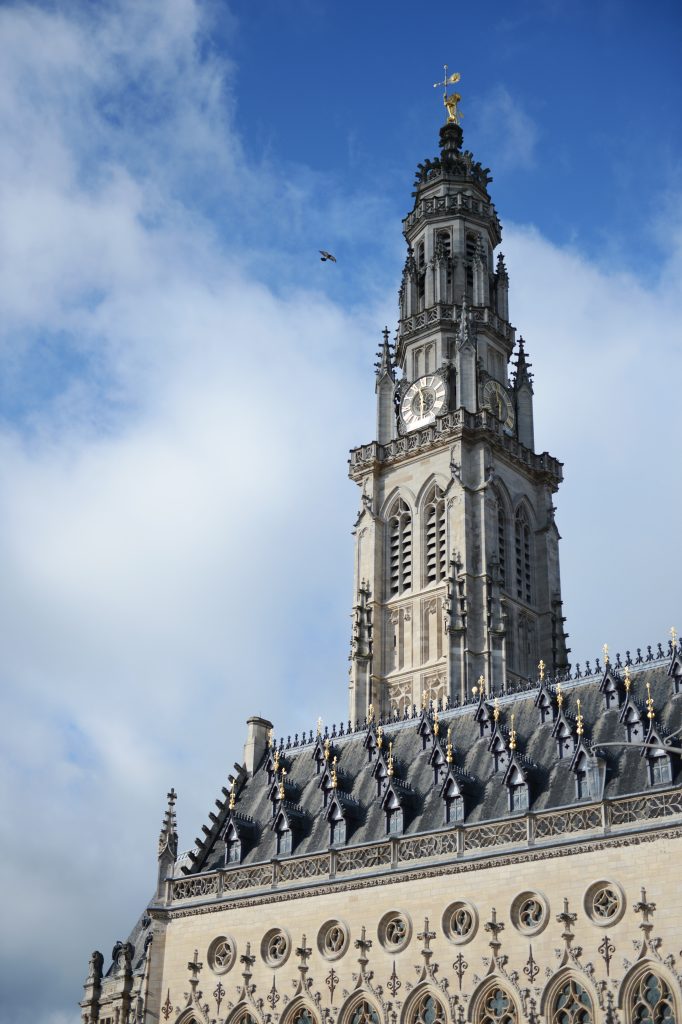
Béthune : a belfry from the 100 Years War era and its WW1 destruction
Loyal to the French Crown during the 100 Years War, Béthune was granted its first belfry in 1346. At the time this represented freedom and the enfranchisement of the community. Initially built on wooden foundations, it soon collapsed following a fire and the town magistrates built a watchtower to replace it. A bell tower was completed in 1503, 17 metres high and surmounted by a dragon that keeps watch over the city.
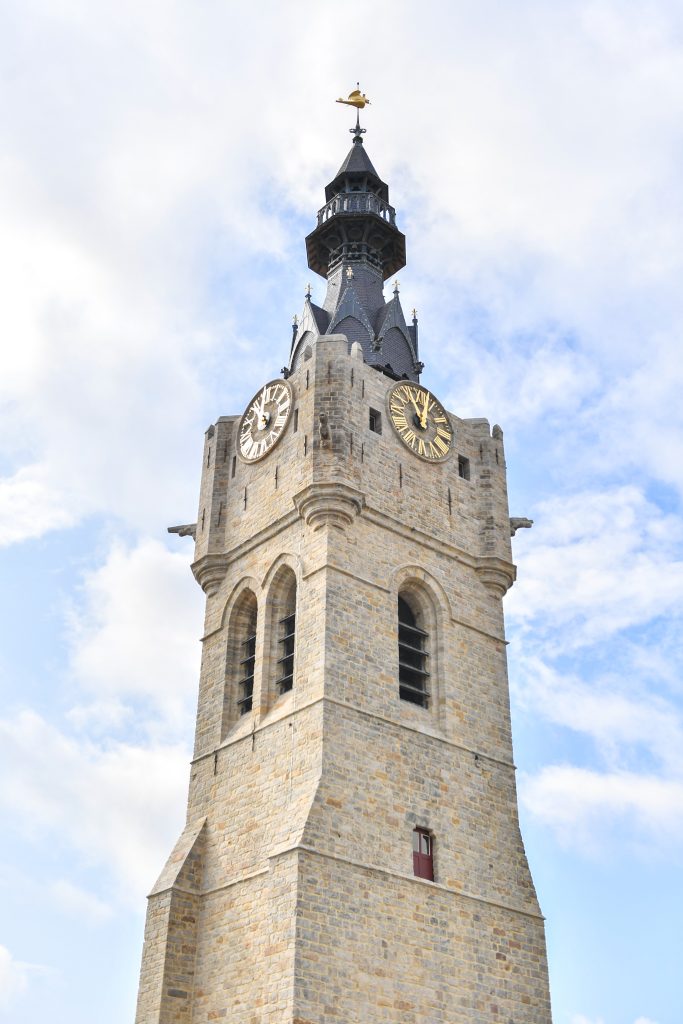
In 1918, Béthune was severely bombed and the belfry was partly destroyed, although its base was saved as it was shielded by the surrounding houses that had been built up against its walls.
The carillon, comprising six bells, was built in 1546 and completed in 1553. It plays traditional tunes: on the hour William Tell, Il Court Il Court Le Furet at quarter past the hour, Le P’ti Quinquin at half past the hour and the song of the Pays d’Artois at a quarter to the hour
The bell tower has four levels. On the first floor is the treasury, a room that holds the town charter. On the second floor is the watchman’s room, whilst on the third and fourth floors are the carillon room and the clock mechanism. Visitors must climb 133 steps to reach the summit and discover a truly breathtaking view of the city.
FIND OUT MORE HERE
12th century bell tower is Boulogne-sur-Mer’s oldest monument
The belfry of Boulogne-sur-Mer is the oldest monument in the old town. Its construction was commissioned by the Count of Boulogne in the 12th century and it served as a seigneurial dungeon. It was handed over to the town’s bourgeoisie in 1230, who turned their belfry into a symbol of freedom.
Romanesque style dungeons organise their spaces vertically, generally superimposing a cellar, a main chamber, the lord’s apartment and an upper level that is reserved for defensive purposes. Of the four levels of Boulogne’s tower, only the first two can safely be attributed to the initial dungeon building. These can be reached via a staircase that is built into the thickness of the wall from the upper level where the entrance is located, according to the basic design of Romanesque dungeons. The chamber on the first floor is topped with a barrel vault, whose orientation has been reversed from that of the ground floor chamber.
Two Gothic vaults and a few statues and sculptures adorn the chambers of this building. On the ground floor, one or two keys decorated with faces from the 18th century are on display.
FIND OUT MORE HERE
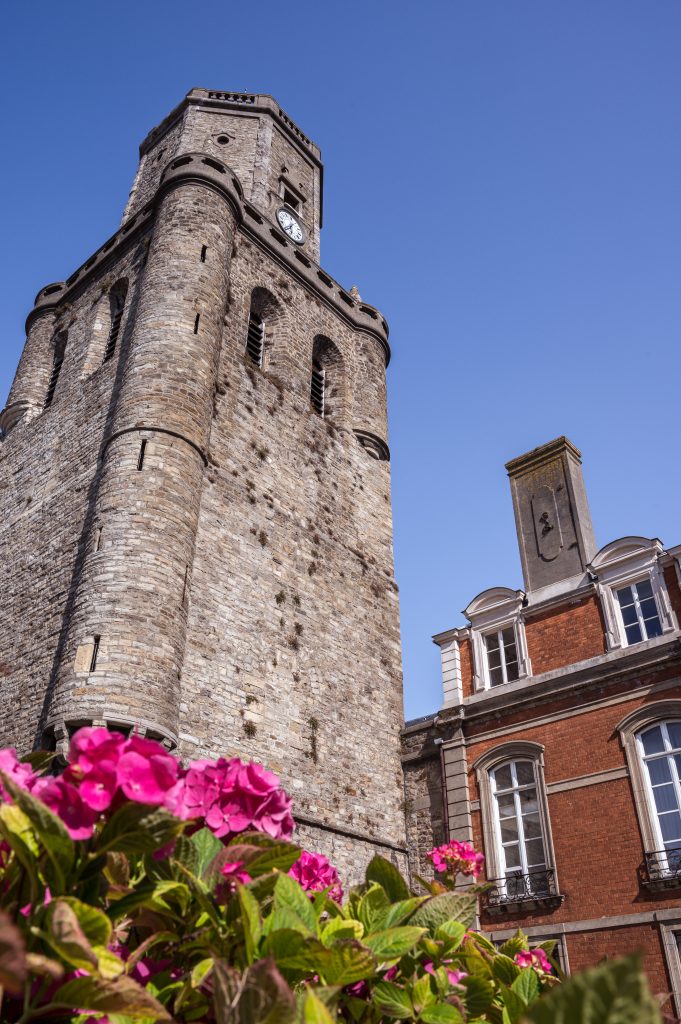
The belfry in Calais : a tale of two cities
Prior to the construction of the belfry, Calais was a double city: on the one side a bourgeois town, and on the other a worker’s city.
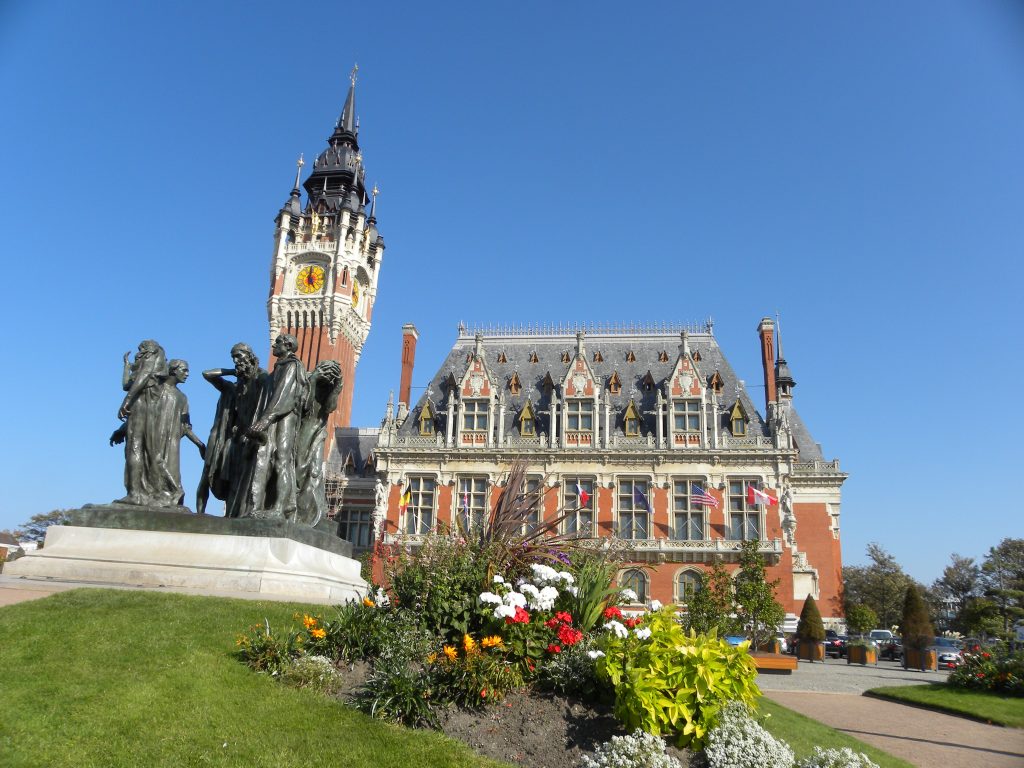
In 1885 the two cities were united; the former market gardening suburbs of Saint-Pierre, which became a workers district devoted to lace making, and bourgeois Calais facing out to sea. It was as a result of this union that the town hall was born.
A powerful symbol of the city, the belfry was built of brick and stone alongside the town hall in the Neo-Flemish style, with four knights in gold leaf at its summit, situated at the four cardinal points. They recall the watchmen that once kept an eye over the city.
From its 75m height, the bell tower allows visitors to admire a panoramic view of the city and its surroundings, and even as far afield as the English coast, weather permitting.
The weather vane that sits at its peak features none other than the dragon; guardian of the treasures.
FIND OUT MORE HERE
Hesdin
Destroyed during the siege of 1639 by the French canons of Meillerade and demolished in 1774 due to disrepair, the bell tower of Hesdin was restored in 1875. Two escutcheons bear an eagle and the coat of arms of Prince Lamoral de Ligne, Governor of Artois, respectively surrounded by the collar of the Order of the Golden Fleece.
The masterpiece of the façade is undoubtedly the brattice, an elegant construction from 1629. The ensemble is adorned with heads, statues and wardrobes. The balcony bears s of Spain, flanked by the escutcheons of Hesdin and Artois.
The statues divided into three groups represent the three divine virtues: Faith, Hope and Charity.
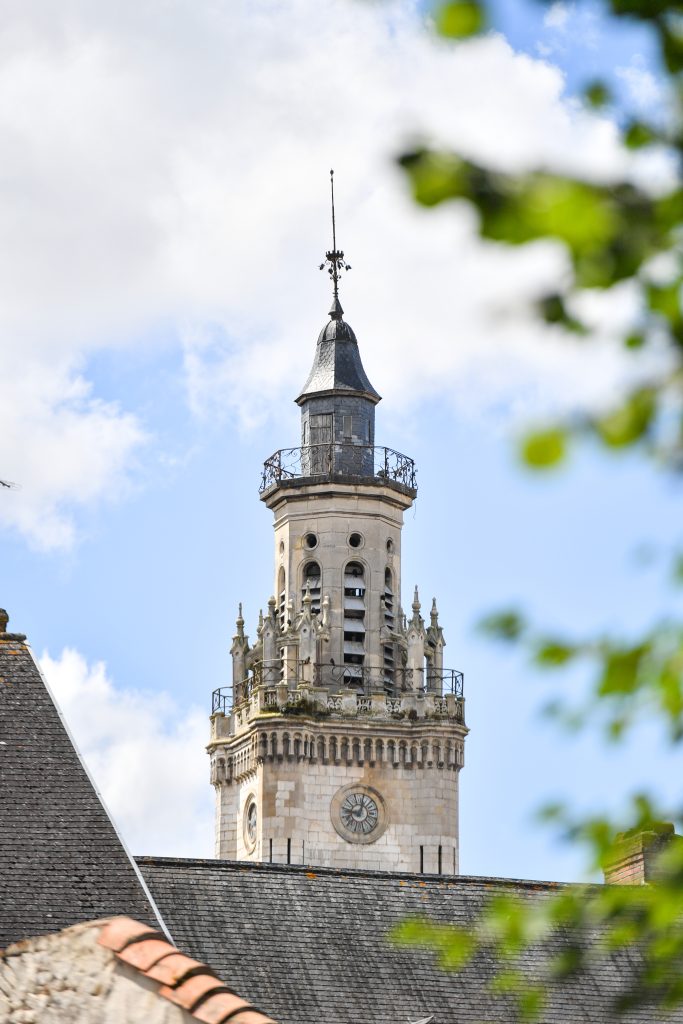
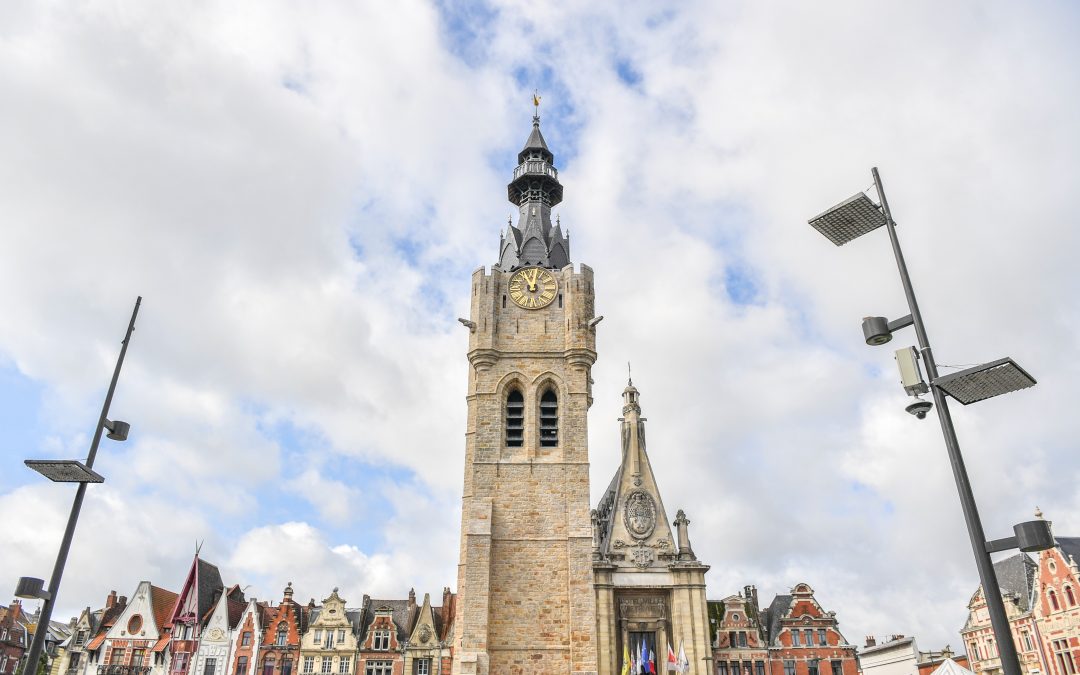
Recent Comments